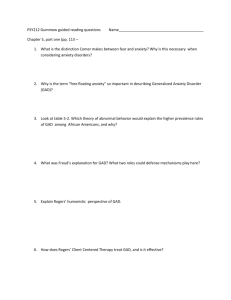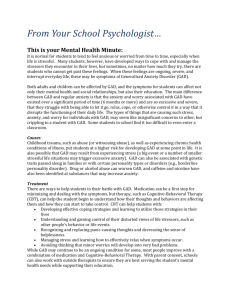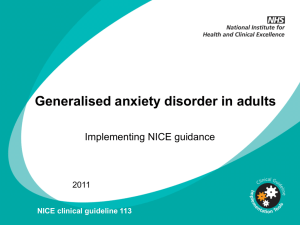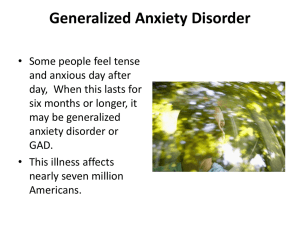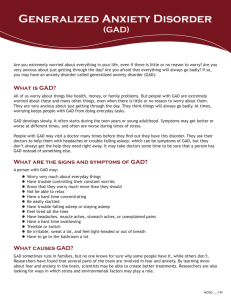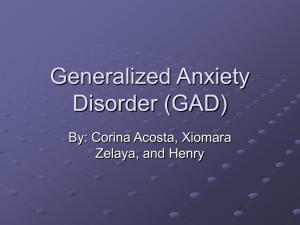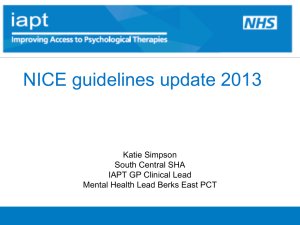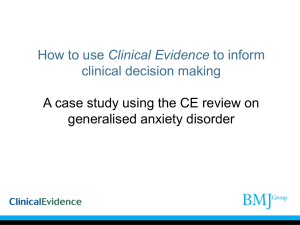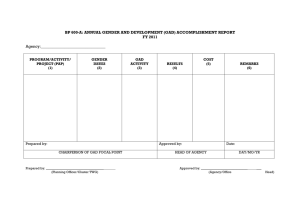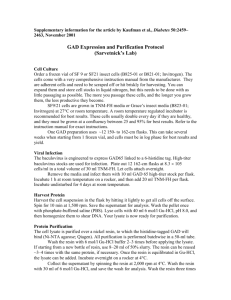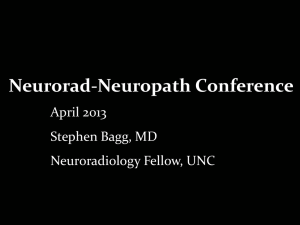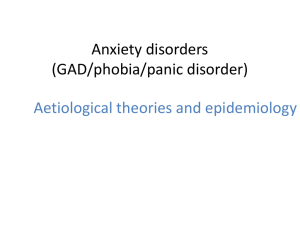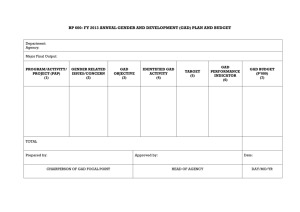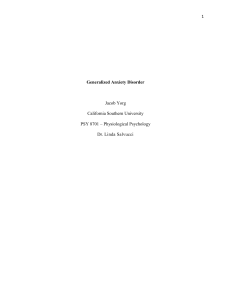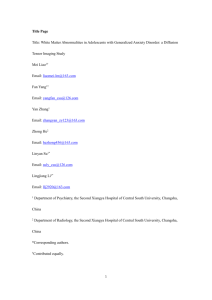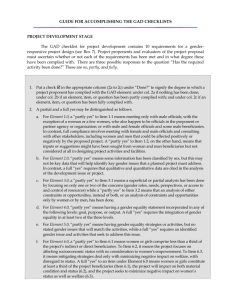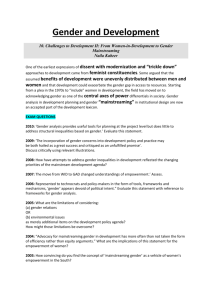Generalised Anxiety Disorder - Atiya Khalid
advertisement
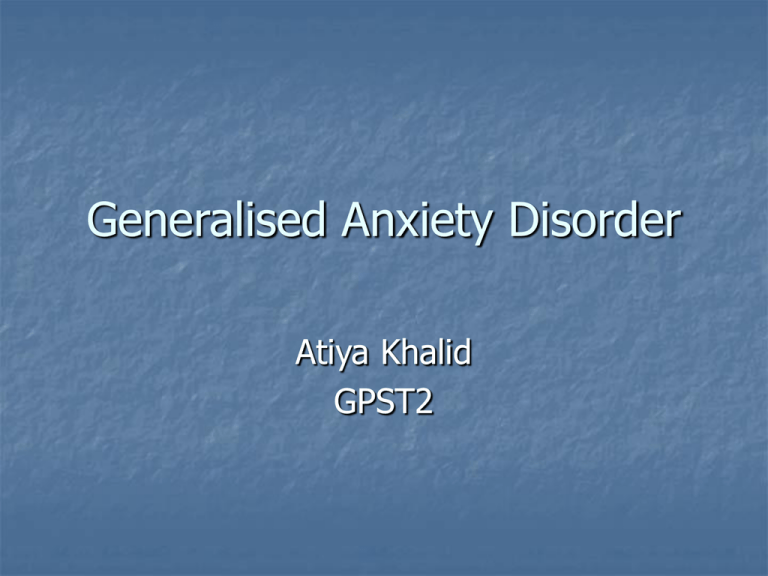
Generalised Anxiety Disorder Atiya Khalid GPST2 What Is GAD GAD is characterised by excessive, exaggerated anxiety & worry about everyday life events with no obvious reasons for worry Curriculum statement 13 Care of people with mental health problems Diagnostic Criteria DSM-IV Excessive anxiety and worry, occurring more days than not for at least six months, about a no. of activities or events Difficulty controlling worry 3 of 6 symptoms are present for more days than not : restlessness ,easily fatigued, difficulty concentrating, irritability, muscle tension, sleep disturbance Epidemiology Lifetime prevalence 5 % ( Europe ),12 month prevalence 1-2% Co-morbidity with major depression 60 % of cases Only 40 % seek help ; 5 yrs remission rate is 38-41% Risk Factors : Being aged between 35 and 54 Being divorced or separated Living alone or as a lone parent Protective Factors: Aged between 16 and 24 Married or in relationship Differential Diagnosis Panic disorder, with or without agoraphobia Post-traumatic stress disorder Obsessive-compulsive disorder Phobias, Social phobia, sometimes called social anxiety disorder Acute stress disorder Contd. Anxiety is commonly a feature of other disorders. Other conditions to consider include: Schizophrenia Dementia Anxiety and depression Alcoholism Physical illness (much less likely to present as simply GAD): Thyrotoxicosis. May produce irritability, restlessness, tremor and tachycardia. Phaeochromocytoma. Normally is part of multiple endocrine neoplasia- usually MEN2. Hypoglycaemia. This is usually part of failure of control of diabetes but insulinoma can be part of MEN SYMPTOMS : Autonomic arousal palpitations, sweating, trembling & dry mouth Chest & abdominal discomfort difficulty breathing, feeling of choking, chest pain & nausea Mental state changes dizziness, feelings of unreality, fear of losing control & fear of dying General: hot flushes or cold chills, numbness or tingling, muscle tension, aches & pain, restlessness & an inability to relax & sensation of lump in throar MANAGEMENT Evidence-based guidelines by NICE The patient's preference for method of treatment. Emphasise that the disease can be managed and give as much information as possible, including written information and access to self-help groups. In terms of long-term effectiveness, the best results are from psychotherapy, followed by medication, followed by self-help. Treatment should be available in primary care with only the most difficult cases requiring referral. Psychological Therapy CBT is the technique of choice for an effective and lasting response. It must be delivered by appropriately trained professionals. The optimum duration of therapy 16 to 20 hours, delivered in a weekly session of 1 or 2 hours and completed within four months. If offering briefer CBT, it should be about 8-10 hours, and should be designed to integrate with structured self-help materials. Anxiety management treatment Is a structured therapy involving > education > relaxation training (involves practising techniques that lead to muscular or bodily relaxation) > exposure (entails graded, repeated confrontation (through visualisation, image, or the stimulus) with a stimulus that causes anxiety. Pharmacological treatment Before prescribing consider: Age of patient Previous treatment response Risks of deliberate self-harm or accidental overdose Tolerability Possible interactions with existing medications The patient's preference Cost, where equal effectiveness NICE recommends a selective serotonin reuptake inhibitor (SSRI) or venlafaxine as the first choice If one SSRI is not suitable or there is no improvement after a 12-week course, and if a further medication is appropriate, another SSRI should be offered. Long-term treatment and doses at the upper end of the indicated dose range may be necessary At the start of treatment, patients should be informed about: Potential side-effects (including transient increase in anxiety at the start of treatment) Possible discontinuation/withdrawal symptoms Delay in onset of effect Time course of treatment Need to take medication as prescribed If there is no benefit in 12 weeks an antidepressant from a different class may be tried. SSRIs and venlafaxine should be tailed off, sudden discontinuation can produce withdrawal. There is no evidence to guide duration of therapy. Any form of medication should be reviewed at 2, 4, 6 and 12 weeks after starting beta blockers, MOA inhibitors, and antipsychotic medication are not effective Monitoring GPs should monitor progress. Review interval; on a case-by-case basis, likely to be every 4-8 weeks. If one form of therapy does not work, another may be tried If two interventions have been tried without success, then referral to mental health services is required PROGNOSIS A chronic disease that is controlled rather than cured Long-term follow-up studies suggest that GAD is a condition that worsens the prognosis for any other condition, and that people who have only GAD are likely to develop further conditions. Stepped care Step 1 Identification and assessment; education about GAD and treatment options; active monitoring Step 2 Low-intensity psychological interventions: individual non-facilitated self-help, individual guided selfhelp and psychoeducational groups Step 3 Choice of a high-intensity psychological intervention (cognitive behavioural therapy/applied relaxation) or a drug treatment Step 4 Highly specialist treatment, such as complex drug and/or psychological treatment regimens; input from multi-agency teams, crisis services, day hospitals or inpatient care Step 1: Identification For all known and suspected presentations of GAD: Identify and communicate the diagnosis of GAD early. Consider a diagnosis of GAD in people presenting with significant worry or who attend primary care frequently because of a chronic physical health problem or somatic symptoms. Step 1: Education, treatment and monitoring Following assessment and diagnosis of GAD: provide education about GAD and options for treatment monitor symptoms and functioning (known as active monitoring). Discuss the use of over-the-counter medications and preparations. Step 2: Low-intensity psychological interventions For people with GAD that has not improved after education and active monitoring in step 1, offer one or more of the following, guided by the person’s preference: individual non-facilitated self-help individual guided self-help Step3:High intensity T/M For people with GAD with marked functional impairment or that has not improved after step 2 interventions offer either: an individual high-intensity psychological intervention using either CBT or applied relaxation or drug treatment using a selective serotonin reuptake inhibitor (consider offering sertraline first because it is the most cost-effective drug) Do not offer antipsychotics for GAD in primary care. Do not offer benzodiazepines except as a short-term crisis measure. Inadequate response to step3 If a person’s GAD has not responded to: a high-intensity psychological intervention, then offer a drug treatment drug treatment, then offer either a high-intensity psychological intervention or an alternative drug treatment. If a person’s GAD has partially responded to drug treatment, consider offering a highintensity psychological intervention in addition to drug treatment. Referral to step 4 Consider referral to step 4 if the person has severe anxiety with marked functional impairment and: a risk of self-harm or suicide or significant comorbidity or self-neglect or an inadequate response to step 3 interventions. Step 4: Highly specialist treatment Consider offering combinations of treatment: psychological and drug treatments or combinations of antidepressants or augmentation of antidepressants with other drugs But exercise caution and be aware of the lack of evidence of effectiveness and increased risk of side effects. References Carter RM, Wittchen HU, Pfister H, et al Slade T, Andrews G Alonso J, Angermeyer MC, Bernert S, et al Gilbody SM, House AO, Sheldon TA Durham RC, Chambers JA, MacDonald RR, et al Ballenger JC, Davidson JR, Lecrubier Y, et al Hawkridge SM, Stein DJ Schmitt R, Gazalle FK, Lima MS, et al Pittler MH, Ernst E Bower P, Richards D, Lovell KJorm AF, Christensen H, Griffiths KM, et al Gale C, Davidson O NICE Guidelines InnovAiT
